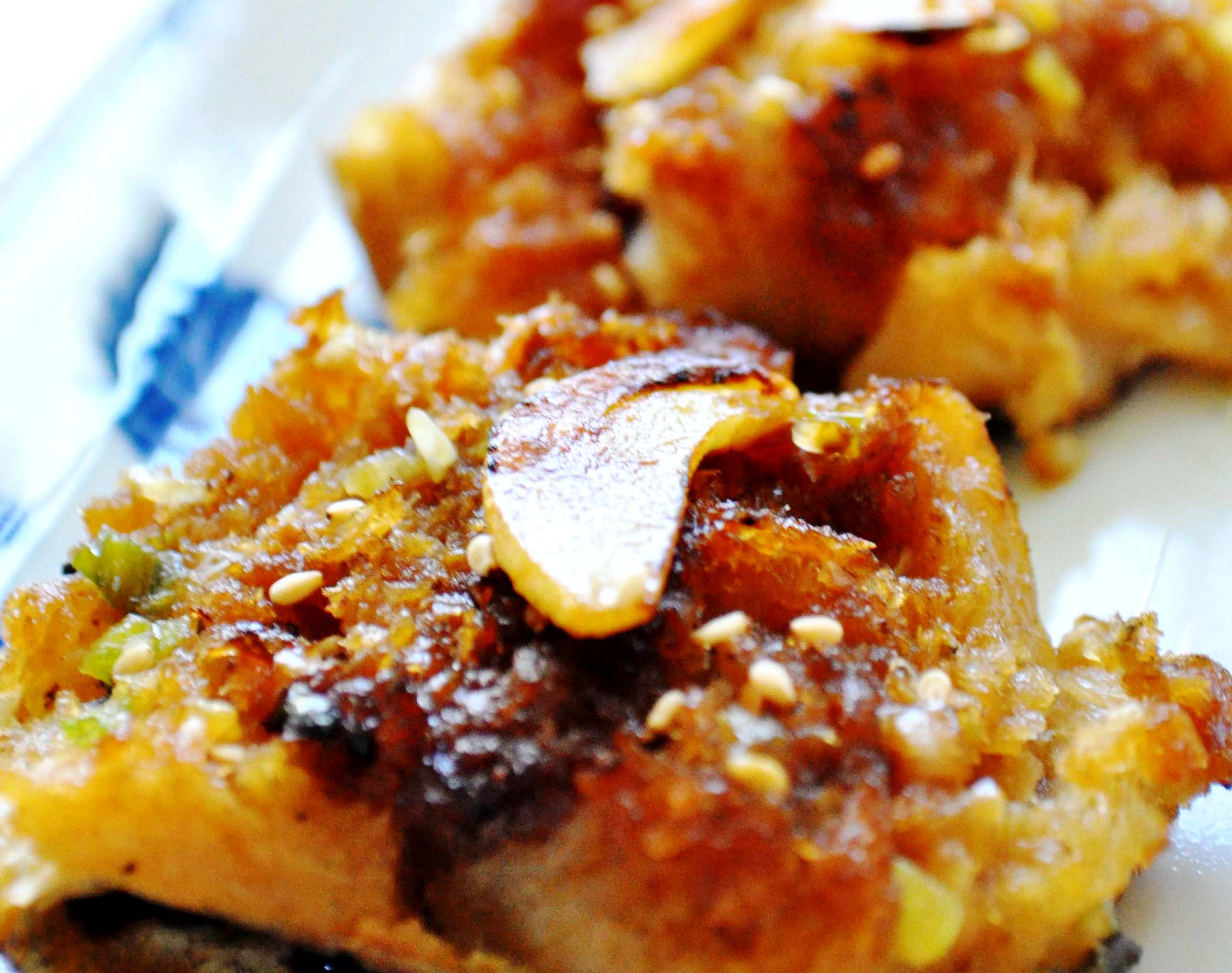
Dried Pollock (북어bugeo) was actually NOT one of my favorite foods when I was a child. I am not sure exactly why but I think it had something to do with the fact that it often had many bones in it and I was never good at avoiding them. The bugeo that’s sold now have almost no bones and being married to a bugeo lover for 20 years, I have grown a true liking to them.
Bugeo (booguh/bukeo/buk-uh) is a great food to have in your pantry/freezer because you can make soups and side dishes out of it at any time. Since bugeo is dried, there’s no need to defrost. And a great thing about this dish is that you can freeze the marinated bugeo pieces in advance and just pan sear them almost instantly.
In Korea, dried pollock (bugeo) is traditionally known to have great health benefits. In general, it is said to have the ability to help the body get rid of toxins and also recover more quickly from a hangover. If you ask any older Koreans who like to drink alcohol, if the dried pollock soup (북어국 bugeo gook) helps them with their hangover, they will all swear by it. I have certainly made my share of bugeo gook in my younger days for my husband – good thing he is now mature and has not had a hangover in years.. My mother-in-law also believes in eating bugeo gook to help one’s body clear away any toxins before and after an herbal medicine regimen. I also remember my parents giving boiled dried pollock head soup to our dogs whenever they ingested something bad (even rat poison – after getting them to throw up the poison first) and most of the time they recovered fully. I searched online in both Korean and English and did not find much research on this but I did find that pollock has an abundant amount of an amino acid called methionine that helps with normal liver function which is essential for elimination of toxins in the body. So make sure you keep some bugeo in your pantry!
About Bugeo and Alaska Pollock
– Dried pollock (bugeo) can be stored at room temperature for weeks but if you want to keep it fresher longer, store it in your freezer.
– Quick note about all the different names Koreans have for the same fish but for the different state it is in.
- 명태 (Myungtae) – is THE name for Alaska Pollock. They are caught in the North Pacific.
- 동태 (Dongtae) – frozen Alaska Pollock
- 생태 (Saengtae) – fresh Alaska Pollock
- 북어 (Bugeo) – fully dried Alaska Pollock
- 황태 (Hwangtae) – also dried Alaska Pollock but the process of drying involves freezing/drying in the cold winter months which produces a more intense flavor and dark yellow color
- 코다리 (Kodari) – semi-dried Alaska Pollock
How to make Bugeo Bulgogi
This bugeo gui is also called 북어 불고기 bugeo bulgogi because the marinade is pretty much the same. You just don’t need any tenderizers because the fish is already very tender. It is also called 북어 양념구이 bugeo yangnyeom gui because the marinade is called 양념 yangnyeom in Korean. However, many people may be talking about the more spicy version that uses gochujang. If you like things spicy, you can just reduce the amount of soy sauce (by 1/2 to 1/3) and substitute gochujang for the reduced amount.
Cooking time: 10 min per batch Prep time: 15 min. Servings: 4 – 6
Ingredients
- 2 dried pollock (bugeo)
- soy sauce marinade (maybe more than you need)
- 6 T soy sauce
- 4 T mirin or rice wine
- 4 T sugar
- 2 T honey
- 1 T sesame oil
- 2 T minced garlic
- 1/2 tsp ground black pepper
- 1 T toasted sesame seeds
- 3 T chopped green onion
- 2 – 3 cloves of thinly sliced garlic (optional)
- 2-3 T sesame oil for frying
1. Reconstitute the dried pollock by soaking in cold water for 10 minutes or so until it becomes soft and spongy.
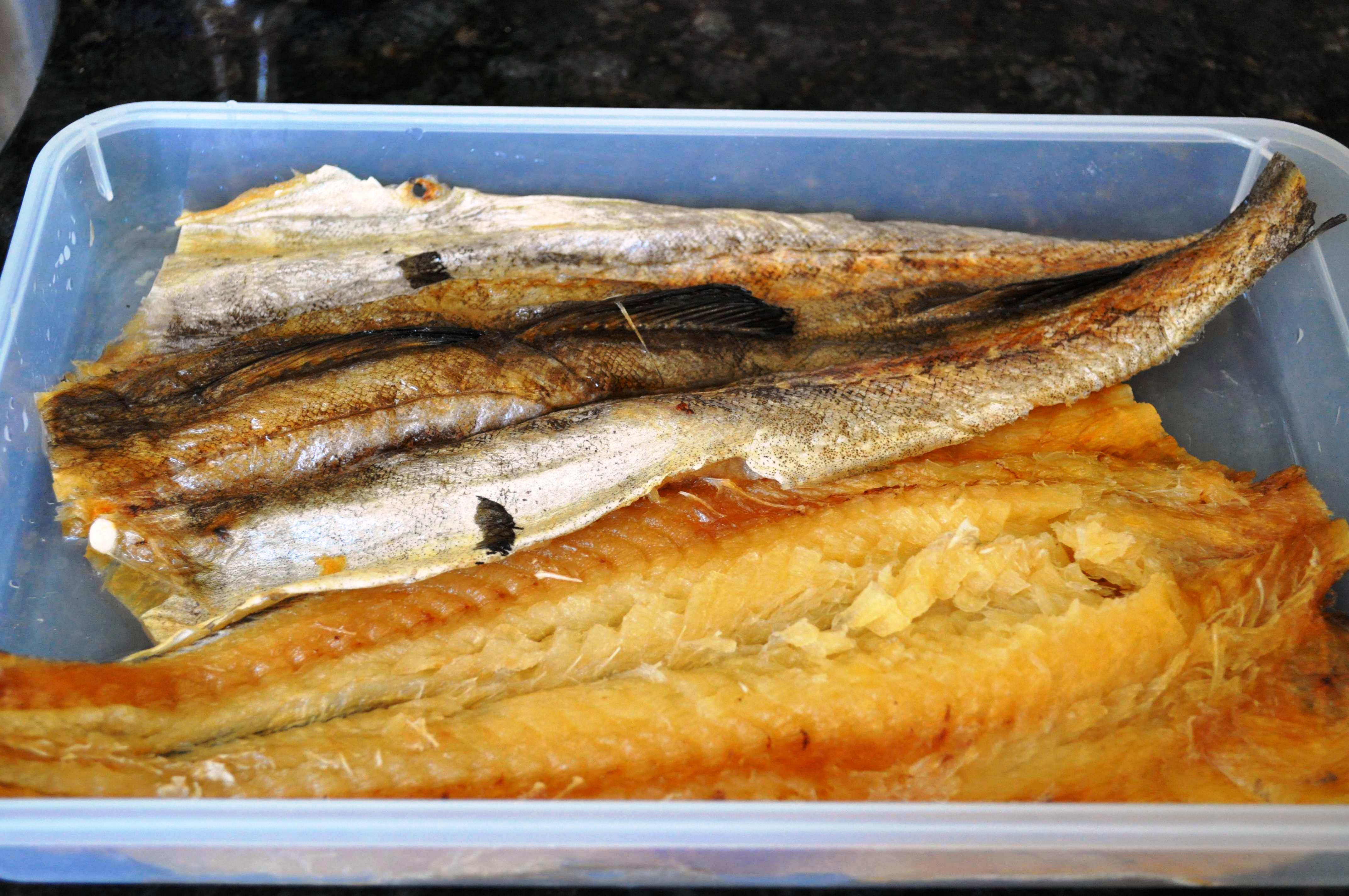
2. In the mean time, prepare the marinade by adding all the ingredients listed above. It is hard to measure the exact amount needed since the sizes of the fishes are all different. The amount I have here is a rough estimate and you should always use less to start and then add more after you taste it. As my mom always used to say – you can usually fix something that’s not salty enough but it’s much harder to fix something that’s already too salty. Too much salt is not good for you anyway…
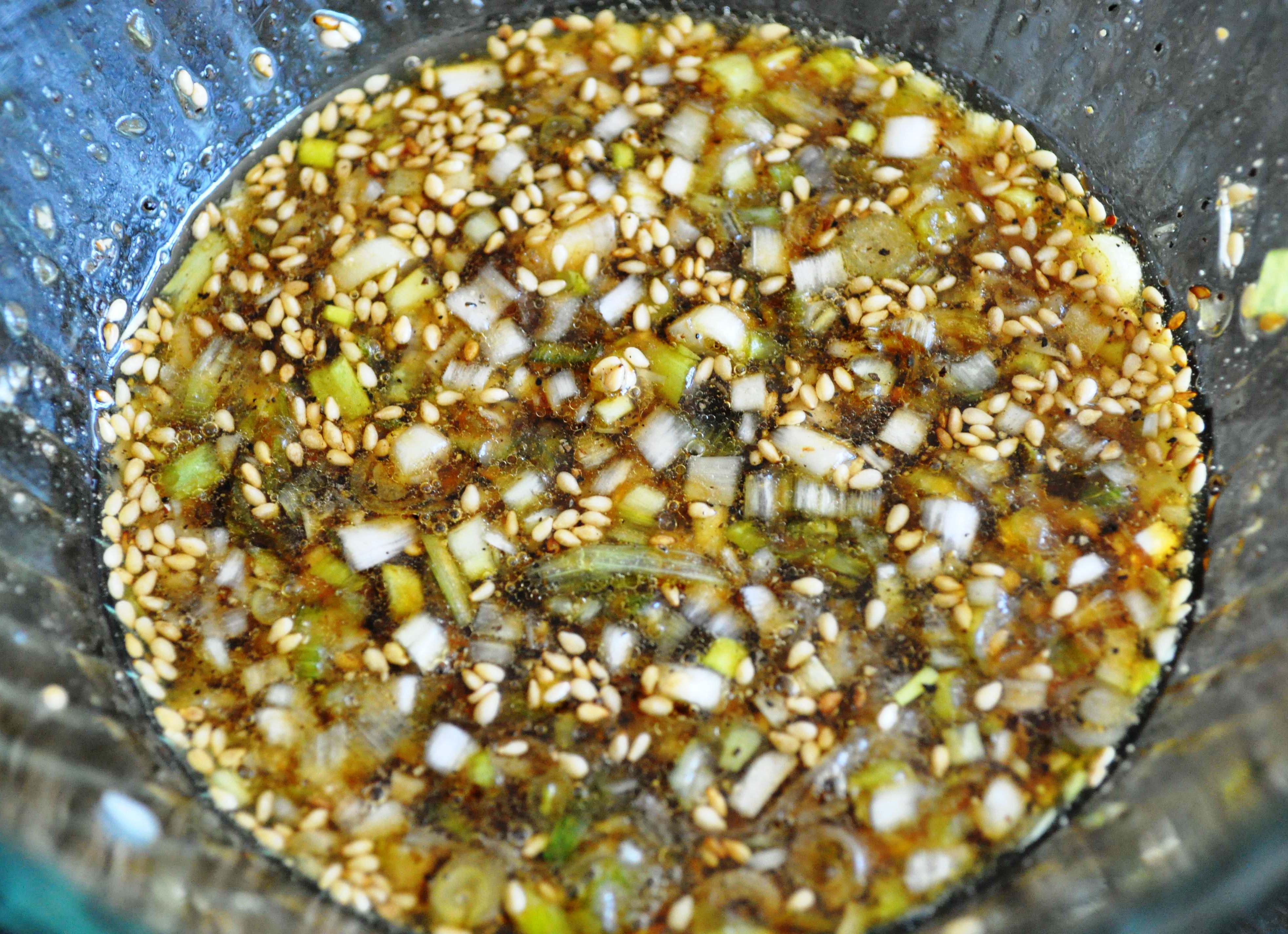
3. When the dried pollock has become soft and fully hydrated, take it out of the water and squeeze lightly to get rid of any excess water. Cut the pollock into 2 inch wide pieces. Spoon the sauce over each piece. I would spread about 1.5 to 2 tsp of the marinade for each piece measuring approx. 2 x 2 in. You can stack them as you go. Note the color below and you may have some sauce leftover if your pollock is smaller than what I have here (mine measured about 11 inches long). The best way is to cook a piece and taste it first and then adjust the amount.
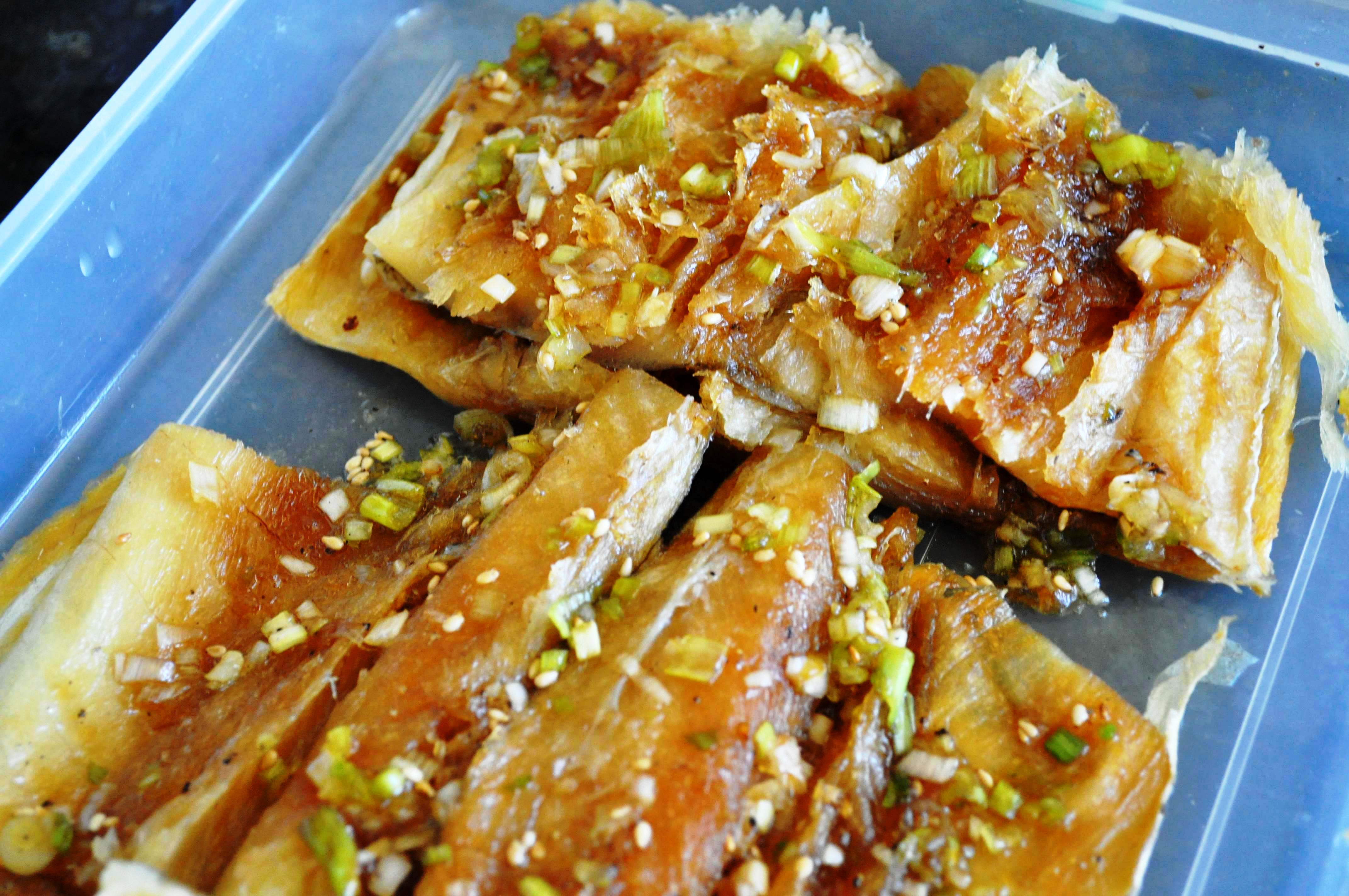
At this point, you can freeze some of the bugeo pieces for later. Whenever you need it, just take them out and pan fry them. The taste does not change at all. My MIL likes to make extra and keep them in the freezer for emergency banchan/side dish.
4. Heat a frying pan on medium high heat with 1 to 1 1/2 T of sesame oil. Sesame oil has a low burning point so watch the pan carefully to prevent burning. You can also mix 1/2 sesame oil and 1/2 canola oil to prevent burning. When the pan is nice and hot, sear the bugeo pieces – 3-4 minutes on each side until they are nicely browned. Lower the temperature to medium to medium low if the pan starts to smoke too much. There is nothing to really cook, you can eat the dried pollock as it is so no need to worry about not cooking it thoroughly. Just try to get a nice sear on both sides to get those wonderful caramelized tastes of soy sauce and sweet sugar and honey.
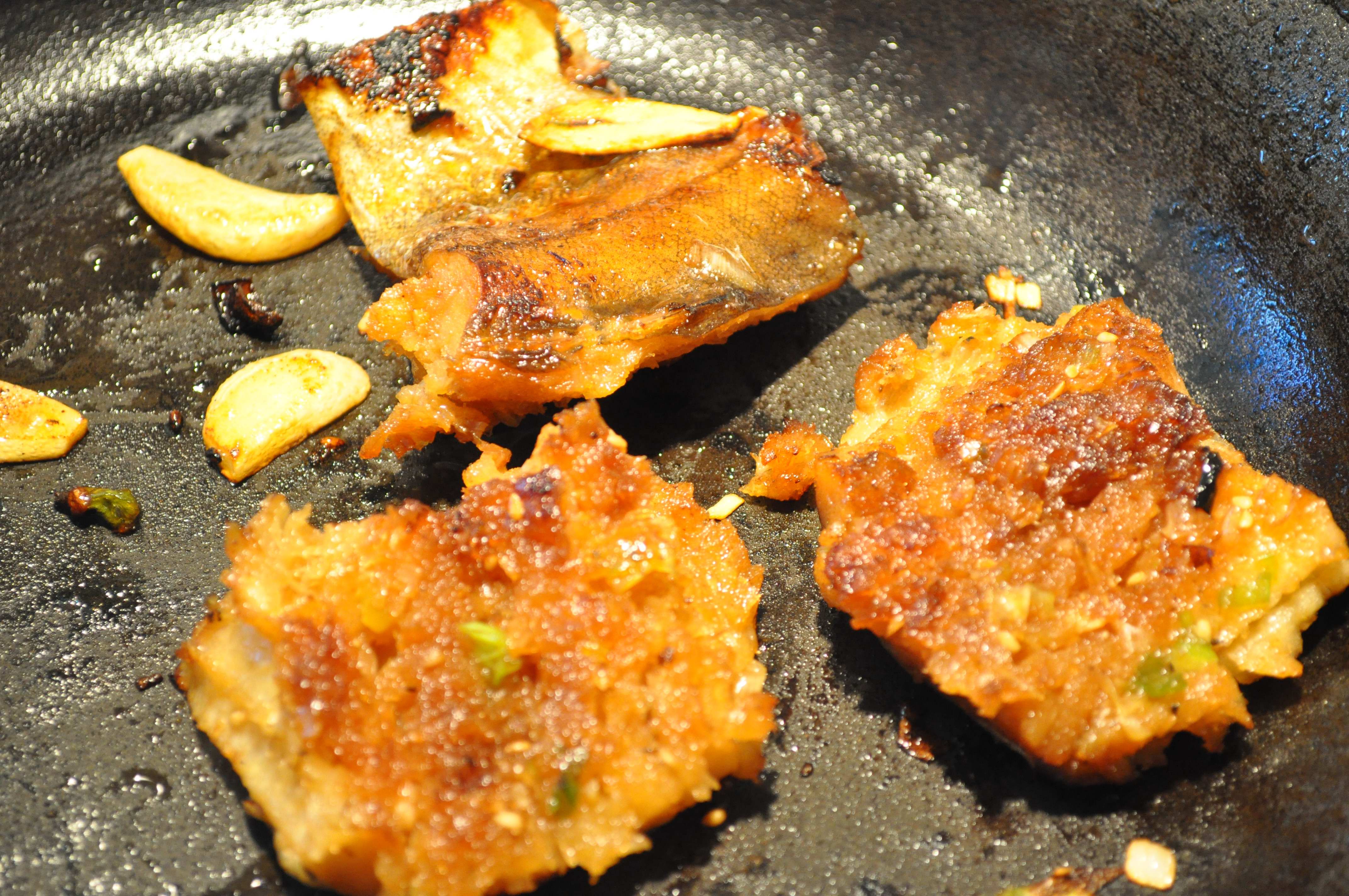
5. Optionally, I fried some garlic slices in sesame oil in the same pan to add as a garnish on top of the fish. You can never go wrong with fried garlic!
That’s it! This is a pretty quick and easy dish to prepare. And it keeps well in room temperature for a day or so – which means it can be a delicious healthy lunchbox (doshirak) side dish (banchan) for both adults and kids. You can also keep any leftovers in the refrigerator and eat it cold or reheat it in the pan. Bugeo is low in fat, high in protein and high in essential amino acids so hopefully you can get some good quality bugeo in your neck of the woods. (I will be posting how to make bugeo gook next and will also discuss about how to buy good quality dried Pollock).
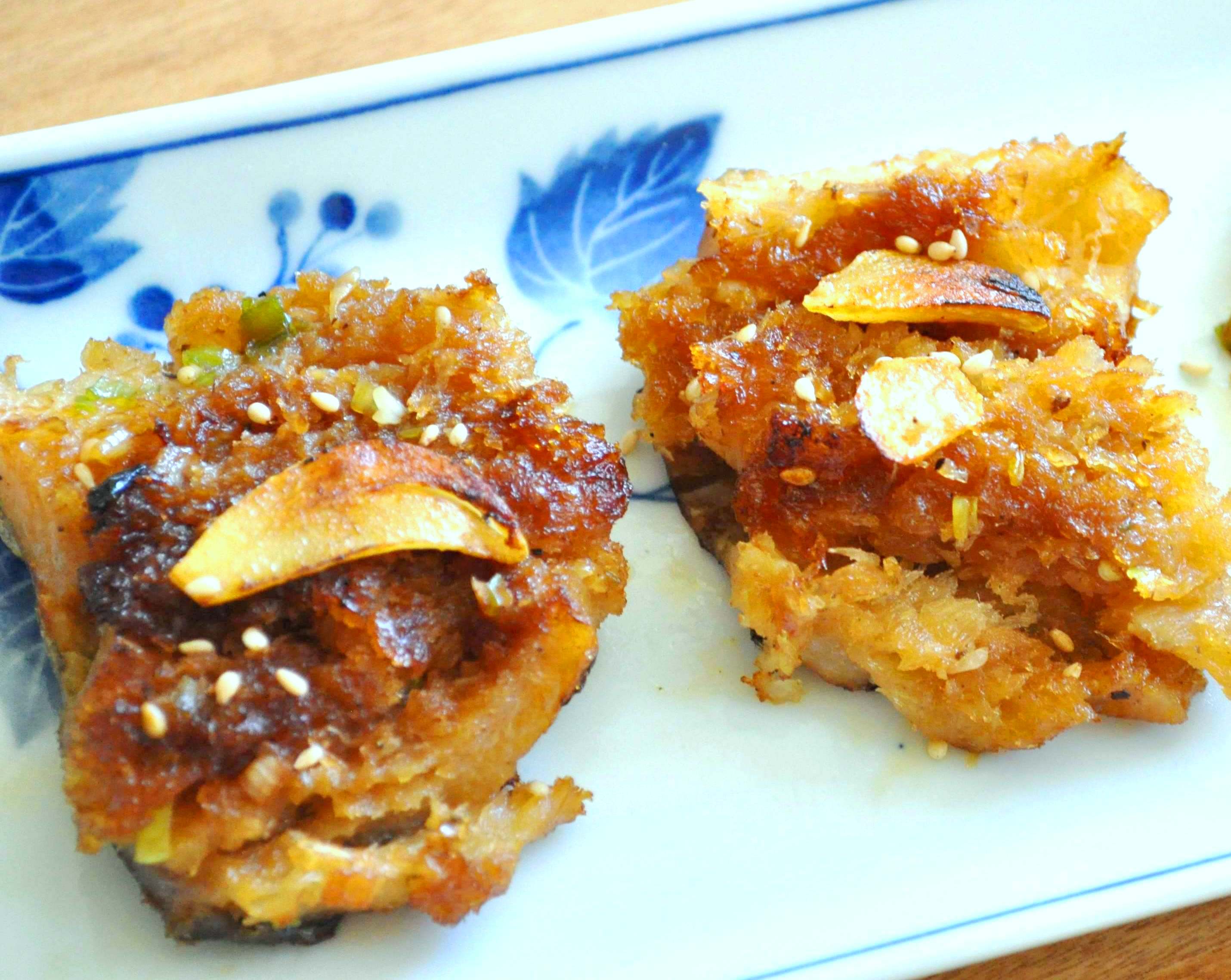
Pan Seared Korean Dried Pollock (Bugeo Gui)
Ingredients
- 2 dried pollock (bugeo, 1 = approx. 100g)
- 2-3 cloves garlic (thinly sliced, optional)
- 2-3 Tbsp sesame oil (for frying)
Soy sauce marinade (maybe more than you need)
- 6 Tbsp soy sauce
- 4 Tbsp mirin or rice wine
- 4 Tbsp sugar
- 2 Tbsp honey
- 1 Tbsp sesame oil
- 2 Tbsp minced garlic
- 1/2 tsp ground black pepper
- 1 Tbsp toasted sesame seeds
- 3 Tbsp chopped green onion
Instructions
- Reconstitute the dried pollock by soaking in cold water for 10 minutes or so until it becomes soft and spongy.
- In the mean time, prepare the marinade by adding all the ingredients listed above. It is hard to measure the exact amount needed since the sizes of the fishes are all different. The amount I have here is a rough estimate and you should always use less to start and then add more after you taste it.
- When the dried pollock has become soft and fully hydrated, take it out of the water and squeeze lightly to get rid of any excess water. Cut the pollock into 2 inch wide pieces. Spoon the sauce over each piece. I would spread about 1.5 to 2 tsp of the marinade for each piece measuring approx. 2 x 2 in. You can stack them as you go. The best way is to cook a piece and taste it first and then adjust the amount.
- At this point, you can freeze some of the bugeo pieces for later. Whenever you need it, just take them out and pan fry them. The taste does not change at all.
- Heat a frying pan on medium high heat with 1 to 1 1/2 Tbs of sesame oil. Sesame oil has a low burning point so watch the pan carefully to prevent burning. You can also mix 1/2 sesame oil and 1/2 canola oil to prevent burning. When the pan is nice and hot, sear the bugeo pieces for 3-4 minutes on each side until they are nicely browned. Lower the temperature to medium to medium low if the pan starts to smoke too much. There is nothing to really cook, you can eat the dried pollock as it is so no need to worry about not cooking it thoroughly. Just try to get a nice sear on both sides to get those wonderful caramelized tastes of soy sauce and sweet sugar and honey.
- Optionally, I fried some garlic slices in sesame oil in the same pan to add as a garnish on top of the fish. You can never go wrong with fried garlic!
- It keeps well in room temperature for a day or so, which means it can be a delicious healthy lunchbox (doshirak) or side dish (banchan) for both adults and kids. You can also keep any leftovers in the refrigerator and eat it cold or reheat it in the pan.

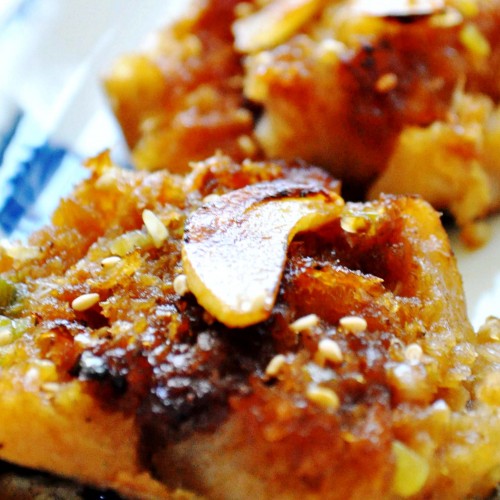

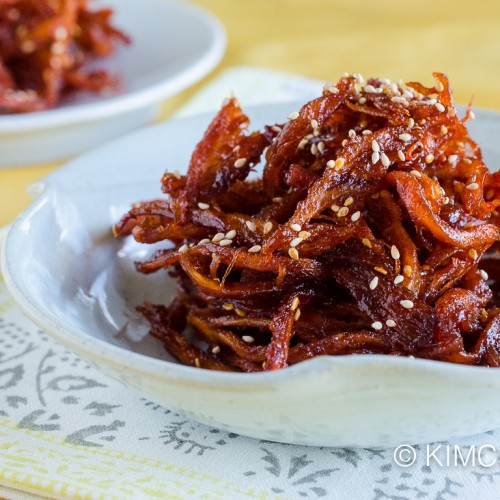
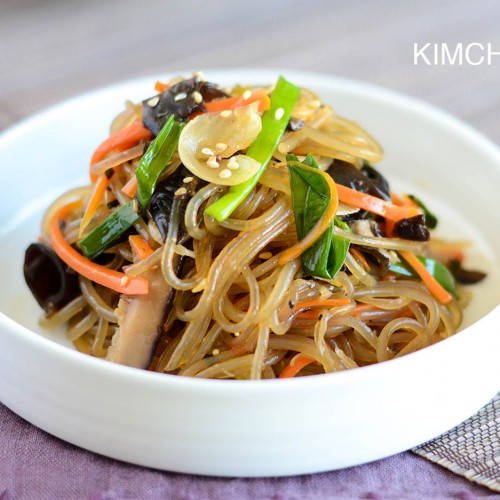
















awwsome, ko map sum ni da
감사합니다! thank you for the 5 stars!
I think this might be the recipe I’ve been looking for since moving back to the US from Korea 4.5 years ago. I never knew what it was called, so I’ve never been able to find a recipe for what I remember. I can’t wait to try it!
I hope you tried it and love it. I do!! Let me know how you like it. Thank you
JinJoo, can I do this with kodari? They were on sale at HanKook Market today and I couldn’t resist, being sure I could find a recipe somewhere!
Hi Judy!!. Sure. Kodari is less dry compared to bugeo so you prob don’t need to soak in water that much. Good luck~
Hi, Jinjoo! Sorry I was away so long, health problems, etc, life in general, but I keep coking only Korean food, so I eat dinner with you (or your recipes, at least) every week! My kimchi last year – made late and with poor cabbage – was delicious anyway and I finished the last of it a few weeks ago. I love my kimchi refrigerator – it was still lovely kimchi after 8 months. I had hoped to get to Korea next year and visit your studio (in the fall, in the hopes of finding a real kimjang to join, and to go to G-Star in Busan) but it’s looking uncertain. We’ll see! I’m planning to cook the pollack this week.
Hi Judy! So good to hear from you!! I too had some health problems so I totally understand how time just flies..I am so glad that you’re liking your Kimchi fridge. I still have my Kimjang from last year and I love making Kimchi jjigae and Kimchi fried rice with it. I really hope you can visit too~ enjoy your bugeo gui!
Thank you so much for your notes on the Korean names of fish. Navigating the names of Korean dishes is difficult. I only have dried pollock in pieces, not whole. Can this dish be made with the strips of fish instead of the whole fish?
Hi! Hmm…strips? I think you can do it. Probably it won’t be as yummy tasting since I find the strips have less flavor than the whole bugeo. But you have to make do with what you have… so I would suggest that you use the same marinade but make sure it doesn’t get too salty. 1. Soak in water for just few seconds as it will quickly absorb all the water 2. Use same marinade but add little first and add more as you go. Make sure it doesn’t get too salty. 3. cook by stir frying (but not stirring too often) because trying to turn over each little strip would make you crazy! It should taste similar – just less body and flavor. Good luck and let me know how it goes! Thanks for stopping by.
Thank you for posting the recipe, I made it tonight and really enjoyed it!
Thank you so much!! Remember that you can make a big batch of it and keep it frozen until you are ready to cook it.